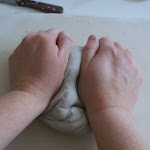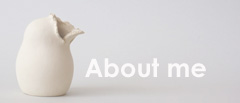That's what I often do. It's a bit more work but it's cheaper and the surprise is bigger when you open the kiln! :)
I never tried to make a red glaze yet so I decided to try if it would work with red iron oxide.
Here is what you need:
Transparant glaze powder (also that you can make yourself but at the moment I use ready made), oxide/pigments/stains, a sieve with a very small mesh, water, containers with a tight lid, a protective mask, a brush, a spoon, some paper and a scale.
 I usually make small amounts so I can make a test tile first. Weigh 100gr of transparant glaze powder.
I usually make small amounts so I can make a test tile first. Weigh 100gr of transparant glaze powder. Then add pigments, body stains or oxides. All three have a different effect on the color. While the result of pigments or body stains are more obvious, the use of oxides is less predictable. So sample tiles are in order before making large amounts.
Then add pigments, body stains or oxides. All three have a different effect on the color. While the result of pigments or body stains are more obvious, the use of oxides is less predictable. So sample tiles are in order before making large amounts.I usually take 3 or 5 grams to 100 grams of transparant glaze. For the red glaze I'm trying to make right now, I'm going to use red ironoxide and I take 10 grams to 100 grams of glaze because I'm afraid that I will get a pink result if I use less.
Put a piece of paper on your scale and weigh the pigment, body stain or oxide on the paper.
 Then add the color to the glaze.
Then add the color to the glaze. Add water & mix the glaze.
Add water & mix the glaze.
 Then put the glaze through the sieve in a container. Using the sieve prevents lumps and makes sure that the color is mixed well with the glaze. I use my brush to push it through the sieve.
Then put the glaze through the sieve in a container. Using the sieve prevents lumps and makes sure that the color is mixed well with the glaze. I use my brush to push it through the sieve. When you're done, write a label on your container so you know what you mixed.
When you're done, write a label on your container so you know what you mixed. Then make a sample tile and fire it. If it's too dark, add more glaze to it or a bit of tin oxide (which makes it lighter).
Then make a sample tile and fire it. If it's too dark, add more glaze to it or a bit of tin oxide (which makes it lighter). This is the result when it's fired... ouch, not quite what I had in mind! LOL
This is the result when it's fired... ouch, not quite what I had in mind! LOLMore experimenting is in order for sure! :)










